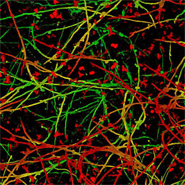Posted 26 May 2009
Scientists uncover sticky nature of pathogenic fungi in bid to treat hospital-acquired bloodstream infections
Scientists have cracked the genetic code of several fungal species which cause hospital-acquired bloodstream infections in patients with suppressed immune systems.
The findings by scientists from University College Dublin, MIT, and Harvard, published in the leading scientific journal Nature, uncovered the ‘sticky’ genetic nature of the pathogenic fungi known as Candida parapsilosis. The scientists claim that its ability to stick to hands and medical devices allows it to take hold on feeding tubes and other indwelling medical devices from where it enters the patient’s bloodstream.
Pictured far right: Candida species growing as biofilms on catheter material
“Premature babies, newborns and patients recovering from surgery are most at risk from this pathogenic yeast-like fungus that is an emerging major human pathogen, and an important cause of bloodstream infection and invasive disease,” says Professor Geraldine Butler from the UCD Conway Institute at University College Dublin, one of the lead scientists involved in the research.
“In order to understand how to treat the infection we first have to understand how the fungi interact with the host,” says Professor Butler. “Before this discovery little was known about the genetic nature of Candida parapsilosis, one of the main causes of hospital-acquired bloodstream infections. Our findings will help scientists to develop potential therapies for the acquired infection.”
At present, the treatment of fungal infections is difficult. Standard antibiotics cannot be used, instead antifungal drugs are applied. There are several antifungal drugs available which can be very effective in treating the infection, but not always. In endocarditis (infections of the heart) surgery is needed, and the mortality rate is still above 40%.
By comparing the genetic make-up of the disease-causing and non disease-causing fungi, the scientists identified that the disease-causing species have many more genes associated with the cell wall, and genes that enable them to successfully stick to the host. According to Professor Butler, these fungi also secrete more enzymes which can help them to invade host tissue.
The hospital-acquired bloodstream infection caused by Candida parapsilosis can lead to deep infections in body tissues and wounds, and almost 30% of patients who acquire these infections die as a result.
The genome sequencing was conducted at the Broad Institute of MIT and Harvard, and the Wellcome Trust Sanger Institute. The analysis was carried out in an additional 18 scientific departments in 6 countries, including the UCD School of Biomolecular and Biomedical Science, University College Dublin and the UCD Conway Institute, University College Dublin, with funding from Science Foundation Ireland.

